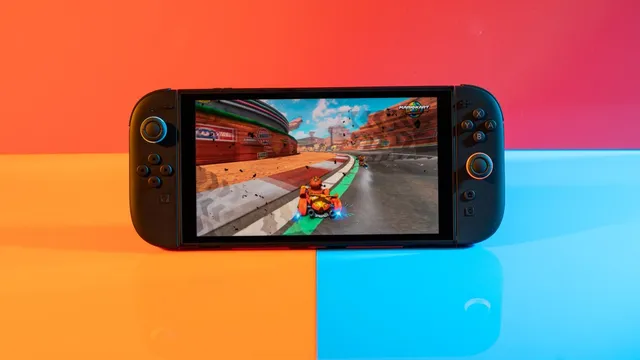
Nintendo's Switch 2 breaks sales records in just four days
2025-06-11 21:30- In just four days, Nintendo sold over 3.5 million Switch 2 consoles, breaking its own sales records.
- The console's early success highlights the effective management of supply amid significant consumer demand.
- Given the current sales pace, Nintendo aims to reach its target of 15 million units sold by March 2026.
Express your sentiment!
Insights
In Japan, Nintendo's Switch 2 launched on June 5, 2025, quickly achieving unprecedented sales figures. Within the first four days of its release, the company announced sales surpassing 3.5 million units, marking a historical milestone for gaming consoles. This impressive launch eclipsed the original Switch's early sales, which totaled approximately 2.7 million units within its first month in 2017, signaling a significant demand for the successor. The gaming industry has been diligently watching these developments, emphasizing the high expectations set for Nintendo as they navigate this competitive market landscape. The phenomenal start is attributed to several factors, including pent-up consumer demand and a carefully managed inventory, which allowed Nintendo to effectively supply its consumers right at launch. Priced at around $449.99, the Switch 2 features advancements like a full HD display and improved performance, positioning it as an attractive option for gamers. Additionally, bundles including popular titles like Mario Kart World have likely fueled initial sales. Analysts are optimistic, noting that Nintendo could potentially exceed its sales target of 15 million units by March 2026 based on current trends and customer engagement. In comparison, historical data reveals that the PlayStation 4 and PlayStation 5 took considerably longer to reach their early sales milestones than the Switch 2, with timelines suggesting that Sony’s PS4 required 16 days to sell 2.1 million units and the PS5 took seven weeks to surpass 4.4 million. By succeeding in rapid sales, Nintendo is illustrating its effective market strategy, focusing on accessibility and social interaction within gaming. This approach has resonated well among consumers, diversifying the player base and encouraging a collective gaming experience. As Nintendo aims to sustain sales momentum, the upcoming launch of additional titles, including a new Donkey Kong game, may continue to enhance interest in the Switch 2. Furthermore, Nintendo's efforts to enhance social features and online interactions signify a shift in their approach to gaming, catering to both seasoned players and newcomers alike. The initial sales figures serve not only as a promising start for the console but also as an indicator of the potential for ongoing success in a highly competitive environment. Considering the enthusiasm shown during the launch period, the future of the Switch 2 looks promising as it strives to cement its place in gaming history.
Contexts
The competition in the Nintendo gaming console market has evolved significantly over the years, shaped by various external factors and innovations. Nintendo, historically known for its groundbreaking consoles like the NES, SNES, and more recently the Switch, has established a unique identity within the gaming industry. Unlike its competitors, such as Sony with the PlayStation and Microsoft with the Xbox, Nintendo has focused on innovative gameplay experiences, unique character franchises, and a user-friendly approach catering to both casual and hardcore gamers. This differentiation strategy has enabled Nintendo to create a strong fanbase and an extensive library of beloved titles, which continues to drive sales and maintain a robust market presence. As of June 2025, the gaming console landscape is characterized by intense competition between the big three players: Nintendo, Sony, and Microsoft. Each company has robust offerings that appeal to different segments of the gaming population. While both Sony and Microsoft have focused heavily on expanding their capabilities in online gaming, cloud services, and high-performance graphics, Nintendo continues to rely on its innovative game mechanics and iconic franchises such as Mario, Zelda, and Pokémon. This contrast represents a fundamental difference in strategy; while the other two companies emphasize graphical fidelity and online connectivity, Nintendo has carved out a niche that highlights family-friendly systems and distinctive gaming experiences. The launch of the Nintendo Switch has been a game-changer, providing hybrid functionality which allows it to be both a home console and a portable device. This versatility has attracted a diverse audience and led to increased sales, particularly among families and younger players. As gaming trends shift toward portability and accessibility, this adaptability of the Switch has not only reaffirmed Nintendo's relevance in a crowded market but has also set the standard for how future consoles might evolve. Furthermore, with the rising demand for retro gaming experiences, Nintendo's established library of older titles remains a significant competitive advantage, drawing in nostalgia-driven customers. Looking ahead, Nintendo faces several challenges in maintaining its competitive edge. The rapid advancement of technology and changing consumer preferences necessitate continuous innovation. Additionally, competition is poised to increase with the advent of new platforms, including cloud gaming and mobile services, which could redefine how gamers access and play titles. In this dynamic environment, Nintendo must continue to leverage its unique strengths, such as creative gameplay and exclusive content, while also exploring new opportunities in digital distribution and online service enhancements. Overall, as the gaming console market becomes increasingly competitive, Nintendo's ability to adapt and innovate will be crucial for its sustained success.